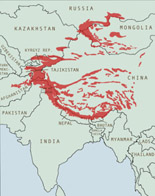In 1980, a Russian study estimated that the Kyrgyz Republic had one of the densest snow leopard populations in the world, but after the breakup of the former Soviet States when the country became independent (in 1991) numbers decreased rapidly, due to illegal hunting by locals whose traditional incomes plummeted.
Corruption was rampant and even those whose job it was to protect endangered animals often colluded in their exploitation. Snow leopard skins were traded for the equivalent of one horse or five domestic sheep at first but by the late 1990’s were worth 30 to 150 times more. Depending on location, snow leopard skins could be obtained during the winter of 1993-94 for a price equal to $US500-2000 which was more than 60 times higher than the minimum yearly wage in Kyrgyzstan. Even today illegal handling of snow leopards and other endangered wildlife continues with the story in April 2010 of the recently deposed President having held 2 snow leopard cubs in a private zoo in a country house.
The key habitat for snow leopards in Kyrgyz republic is the Sarychat-Ertash Zapovednik (Protected Area), which was designated in 1995 to protect the ecosystems of the Central Tian Shan mountain ranges. The reserve covers 1340 square kilometres south-east of Lake Issyk-Kul in the Ak-Shiyrak range. The highest peaks rise to roughly 5,200 metres and has lush valleys and craggy rock scree areas making it perfect snow leopard habitat. The reserve holds a number of threatened species, including snow leopards, the snow leopard prey argali andgrey wolf. Despite it being illegal to hunt these and other animals in the reserve, hunting does occur.
Conservation projects
In 1999, the German Society for Nature Conservation (NABU) signed an agreement with the Ministry of Environment for a snow leopard conservation program to go till 2011. The primary objective was to set up the anti-poaching team (Gruppa Bars) as well as environmental education, research, and eco-tourism.
NABU was the first organization to become actively involved in the conservation of the species in Kyrgyzstan following the depletion of numbers that had apparently occurred during the 1990s.
Since they were set up the Kirghiz Gruppa Bars (anti poaching unit) have been busy. They’ve confiscated 3 live snow leopard cubs and 16 Snow Leopard skins. Over 100 poachers and traders have been arrested, and hundreds of traps designed for snow leopards destroyed.
The arrests and undercover investigations show an organised trade that has worked with both organised as well as opportunistic suppliers in Kyrgyzstan. Many of the snow leopard body parts were destined for China and Russia.

Kuban, Country program coordinator, Snow Leopard Trust and Chair of the Snow Leopard Foundation in Kyrgyzstan. (Photo SLT.)
The Snow Leopard Trust has a number of projects in the Kyrgyz republic. These include the Snow Leopard Enterprises program that helps local people with training and equipment to make and sell beautiful wool and felt handicrafts, thus earning income while in return agreeing to keep snow leopards alive. SLT staff has also developed educational materials on ecology and nature conservation.
Ongoing research work in the Kyrgyz Republic by SLT also includes a recent study comparing trap cameras and other methods in the Sarychat Ertash wildlife reserve and other protected areas, for estimating snow leopard population sizes. In 2005 the Snow Leopard Trust and Dr Alexander Vereshagin set up 22 cameras in the Sarychat Ertash reserve, some in areas where there was evidence of snow leopards, and were able to project themovement of a handful of animals.
Flora and Fauna International is also working on snow leopard conservation in joint projects with the Snow leopard trust. These projects include abiodiversity monitoring strategy, to provide information on the status and trends in the reserve’s ecosystems and resources and an anti-poaching strategy for the snow leopard. Read more about snow leopards in Kyrgyzstan here.






